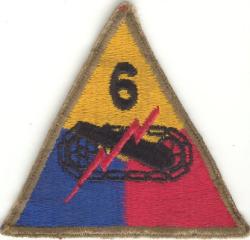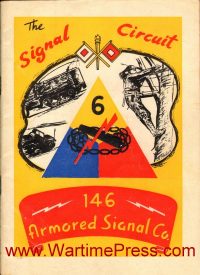
Nickname: Super Sixth ….. Shoulder Patch; Regular armored patch with numeral. Red area (FA), yellow (Cav.) and blue (Inf.) with red bolt of lightning crossing tank track and cannon. ….. Training: Activated: Feb. 15, 1942, Ft. Knox, Ky., assigned to Armored Force, AGF, Mar., 1942, Camp Chaffee, Ark. Maneuvers: La., Aug.-Sept., 1942. Other stations: Camp Young, Calif.. Camp Cooks, Calif., II Armored Corps and XVII Corp and Fourth Army Command. Overseas: Jan.-Feb., 1944 (ETO). Five months training in Great Britain. ….. Commanding Generals: Maj. Gen. William H. H. Morris, Jr., Feb., 1942, to May, 1943; Maj. Gen. Robert W. Grow, May, 1943, to present. ….. Component Units: (As of Jan., 1944) 128th, 212th end 231st Arm. FA Battalions.; 15th, 68th and 69th Tank Battalions.; 9th, 44th and 50th Armored Infantry Battalions. Higher Commands: Third Army. ….. Combat Highlights: The 6th Armored Division helped open a liberation path from Brest to Bastogne along the road to Berlin. The “Super 6th” hit Omaha Beach in Normandy in July, 1944, and swung to the Brest peninsula through Lessay, Granville, Avranches and Dinan. Then began the sweep across France, bitter fighting through Lorient, Angers, Orleans, Autun, Nancy, Letricourt, Pont-a-Mousson and Metz. Withdrawn from the Saar river area, Dec. 24, the men of the 6th were rushed to the Third Army front during von Rundstedt’s winter offensive. They relieved the 10th Armored Division north of Mersch, Luxembourg. By the end of December, the 6th shifted to positions northeast of Mersch, throwing its weight against the desperate German drive. The pocket in which the 101st Airborne Division and armored units had made so gallant a stand had become a bulge. Facing it was one of the greatest enemy concentrations since the Ardennes Forest offensive started. For 23 snow-bound days, the men of the 6th and the Nazis fought a see-saw battle, a number of towns changing hands several times. Slowly the Germans were beaten back, but with strong rearguard action, they completed a 20-mile withdrawal into Germany by Jan. 26, 1945. Bastogne was secured by the Yanks. The following month, the 6th was one of the forward units of the Third Army which brought disaster to the Germans in the Saar-Mozelle-Rhine triangle. Fighting the Germans where they found them, men of the 6th along with units of the 4th Armored, crossed the Kyll and Moselle rivers and overran such towns as Kassel, Weimar, Jena and Gotha. At war’s end, the division was pulled back to Weimar. The division was recently reported standing by for return to the United States along with other divisions not intended for occupation use.




